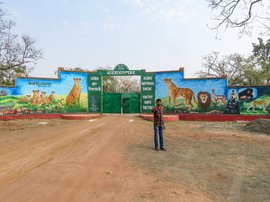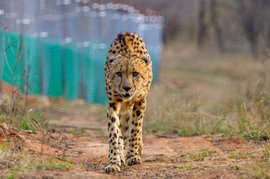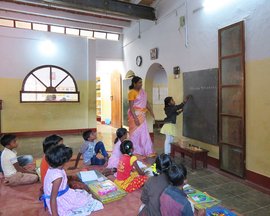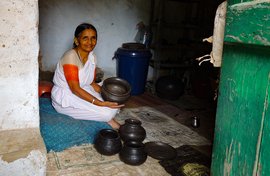You don’t keep the King of the Jungle waiting.
The lions were coming. All the way from Gujarat. And everyone else had to move on to make their entry painless.
And that seemed a good thing. Even if the villages like Paira inside Madhya Pradesh’s Kuno National Park were uncertain of how it would all go.
“After the great cats arrive, this area will become famous. We will get jobs as guides. We can run shops and eateries in this location. Our families will thrive.” That’s Raghulal Jatav, in his 70s, talking to us in Agara village outside the Kuno Park.
“We will get good quality irrigated land, all-weather roads, electricity for the whole village, and all civic amenities,” Raghulal says.
“That’s what the
sarkar
[government] assured us, anyway,” he says.
And so the people of Paira and some 1,600 families across 24 villages vacated their homes in the Kuno National Park. They were mainly Sahariya Adivasis, and Dalits and poor OBCs. Their journey into exile was a hurried one.
Tractors were brought in, and the forest dwellers piled many generations of possessions to hastily leave their functioning homes behind. They also left primary schools, hand pumps, wells, and land they had tilled for generations. Even cattle were abandoned. For they would be a burden to feed without the ample grazing resources of the forest.
Twenty-three years later, they’re still waiting for the lions.


Left: Raghulal Jatav was among those displaced from Paira village in Kuno National Park in 1999. Right: Raghulal (seated on the charpoy), with his son Sultan, and neighbours, in the new hamlet of Paira Jatav set up on the outskirts of Agara village
“The government lied to us,” says Raghulal, seated on a charpoy outside his son’s home. He’s not even angry anymore. Just tired of waiting for the state to honour its promises. Thousands of poor, marginalised people like Raghulal – himself a Dalit – gave up their lands, their homes, their livelihoods.
But Raghulal’s loss was not Kuno National Park’s gain. No one has got the lion’s share. Not even the great cats themselves. They never came.
*****
Lions once roamed the forests of central, northern and western India. Today, though, the Asiatic lion ( Panthera leo leo ) can only be found in the forests of Gir. And in its surrounding landscapes covering 30,000 square kilometres in the Saurashtra peninsular region in Gujarat. Less than six per cent of that area – 1,883 sq. km – is their last protected home. A fact that sends wildlife biologists and conservationists into a cold sweat.
The 674 Asiatic lions recorded here are listed as an endangered species by the International Union for Conservation of Nature (IUCN), the world’s leading conservation agency. And wildlife researcher Dr. Faiyaz A. Khudsar points to a clear and present danger. “Conservation Biology clearly suggests that if a small population is restricted to a single site, it faces a variety of extinction threats,” he says.
Khudsar is referring to multiple threats the great cats face. These include an outbreak of canine distemper virus, forest fires, climate change, local rebellion and more. Such dangers, he says, could swiftly decimate this fragile population. That is a nightmare scenario for India as images of the lion dominate our official state emblems and seals.
There is no alternative to Kuno as an additional home for the lions, insists Khudsar. As he puts it: “It is essential to reintroduce a few prides [of lions] throughout their historical geographical ranges to promote genetic vigour.”


Left: A police outpost at Kuno has images of lions although no lions exist here. Right: Map of Kuno at the forest office, marked with resettlement sites for the displaced
Though the idea goes back much earlier – it was around 1993-95 that a translocation plan was drawn up. Under that plan, some lions would be moved from Gir to Kuno 1,000 kilometres away. Dr. Yadvendradev Jhala, dean of the Wildlife Institute of India (WII) says that from a list of nine possible locations, Kuno was found best suited for this plan.
The WII is the technical arm of the Ministry of Environment, Forests and Climate Change (MoEFCC) and state wildlife departments. It has played an important role in the reintroduction of tigers in Sariska, Panna, Gaur in Bandhavgarh, and Barasingha in Satpura.
“Kuno’s overall size [a contiguous habitat of around 6,800 sq. km], its relatively low levels of human disturbance, no highways running through it, all these made it a fine location,” says conservation scientist Dr. Ravi Chellam. He has tracked these mighty mammals for four decades.
Other positive factors: “Good quality and diversity of habitats – grasslands, bamboo, wet patches. And then there are perennial massive tributaries to the Chambal [river] and diverse species of prey. All these made this sanctuary ready to play host to lions,” he says.
However, thousands of people would have first had to be moved out of Kuno sanctuary. Displacing and relocating them miles away from the forests on which they depended, was done in a few years.
Twenty-three years later, though, the lions are yet to show up.
*****


Left: An abandoned temple in the old Paira village at Kuno National Park. Right: Sultan Jatav's old school in Paira, deserted 23 years ago
For the residents of the 24 villages within Kuno, the first hint of a possible displacement came in 1998. That was when forest rangers around here began speaking of the sanctuary turning into a national park – with zero human presence.
“We said we have lived with lions [in the past]. Also with tigers and other animals. Why do we have to move?” asks Mangu Adivasi. He is a Sahariya in his 40s, and among those displaced.
In early 1999, not waiting for the villagers to be convinced, the forest department began clearing large tracts of land outside the Kuno boundary. Trees were felled and land was levelled with J.C. Bamford excavators (JCBs).
“The relocation was voluntary, I personally supervised it,” says J.S. Chouhan. In 1999, he was the district forest officer for Kuno. He is presently the principal chief conservator of forests (PCCF) and chief wildlife warden of Madhya Pradesh.
To sweeten the pill of displacement, each family was told that their unit would get two hectares of ploughed and irrigated land. All male children above the age of 18 would also be eligible for this. They would also be entitled to Rs. 38,000 to build a new house and Rs. 2,000 to transport their belongings. Their new villages, they were assured, would have all civic amenities.
And then the Palpur police station was deactivated. “It set off alarm bells as dacoits are feared in this area,” says Syed Merajuddin, 43. He was a young social worker in the area at that time.
The host villages were neither consulted on, nor compensated, for the influx. Nor for the loss of access to forests which had now been levelled
The summer of 1999 arrived. Just as they were readying to plant their next crop, the residents of Kuno instead began to shift. They arrived in and around Agara and set up homes in blue polythene shacks. They would live here for the next 2-3 years.
“The revenue department initially did not recognise the new owners of the land and so records were not given. It took 7-8 years for other departments like health, education, and irrigation to get moving,” says Merajuddin. He went on to become secretary of the Aadharshila Shiksha Samiti. That’s a non-profit which runs a school for, and works with, the displaced community in host village Agara.
Twenty-three years later, PCCF Chouhan admits that “Village relocation is not the job of the forest department. The government has to
own
the relocation, only then will the displaced person get the full package. All departments must reach out to the people. It is
our
duty,” he says, when asked to comment on the unfulfilled promises.
The villages of Umri, Agara, Arrod, Chentikheda and Deori in Vijaypur
tehsil
of Sheopur district witnessed an influx of thousands of people from the 24 displaced villages. These host villages were neither consulted on, nor compensated, for the influx. Nor for the loss of access to forests which had now been levelled.
Ram Dayal Jatav and his family moved into the Paira Jatav hamlet outside Agara in June 1999. A decision that the resident of the original Paira in Kuno Park, now in his 50s, still regrets. “The resettlement was not good for us. We faced a lot of problems and still do. Even today we don’t have water in our wells, fencing for our farms. We have to bear the cost of medical emergencies and it is difficult to secure employment. Besides, there are so many other problems,” he says. His voice trails off as he adds: “They did good only for the animals but did nothing good for us.”


Left: Ram Dayal Jatav regrets leaving his village and taking the resettlement package. Right: The Paira Jatav hamlet where exiled Dalit families now live
Raghulal Jatav says the loss of identity has been the hardest blow: “It has been 23 years and apart from not getting what we were promised, even our independent gram sabhas were merged into existing ones here.”
He has been fighting the declassification of the 24 villages including his own Paira. According to Raghulal, when the new
gram panchayat
was formed in 2008, Paira was stripped of its title as a revenue village. Its residents were then added to existing
panchayats
in four hamlets. “This was how we lost our
panchayat
.”
A pain that PCCF Chouhan says he has tried to remedy. “I have reached out to many people in the government to give them back their own
panchayat
. I tell them [state departments], ‘you shouldn't have done this’. Even this year I tried,” he says.
Without their own
panchayat
, the displaced face a complex legal and political battle for their voices to be heard.
*****
Mangu Adivasi says that after the displacement “the forest closed down for us. We used to sell grass as fodder, but now we don’t get enough to keep even one cow.” There’s also the loss of grazing, firewood, non-timber forest produce, and more.
Social scientist Prof. Asmita Kabra points out the irony: “People were made to leave their homes as the forest department was worried about possible losses to cattle [from the lions thought to be coming]. But ultimately, the cattle were left behind as there was no grazing outside for them.”


Left: Mangu Adivasi lives in the Paira Adivasi hamlet now. Right: Gita Jatav (in the pink saree) and Harjaniya Jatav travel far to secure firewood for their homes
The treeline moved further away as land was cleared for cultivation. “Now we have to travel 30-40 kilometres to get firewood. We may have food, but there is no firewood to cook it,” says Kedar Adivasi, a 23-year-old teacher and resident of Aharwani, one of the villages the displaced Sahariyas relocated to.
Gita, in her 50s, and Harjaniya, in her 60s, were very young when they wed and left their homes in Sheopur’s Karahal tehsil to live in the sanctuary. “[Now] we have to go up the hills to get wood. It takes us the whole day and we often get stopped by the forest department. So we have to be discrete,” says Gita.
In their rush to settle things, the forest department bulldozed valuable trees and scrub, recalls Kabra. “The loss of biodiversity was never calculated,” adds the social scientist whose PhD was on displacement, poverty and livelihood security in and around Kuno. She is regarded as the foremost conservation displacement expert on this region.
The loss of access to chir and other trees for collecting gums and resins is a big blow. Chir gond sells at Rs. 200 in the local market, and most families would manage to collect around 4-5 kilos of the resin. “ Gond resin of many different kinds used to be plentiful as were tendu leaves [from which beedis are made ]. So too, fruit like bael, achar, mahua , honey and roots. All this kept us fed and clothed. A kilo of gond we could exchange for five kilos of rice,” says Kedar.
Now many like Kedar’s mother, Kungai Adivasi, who has only a few rain-fed bighas of land in Aharwani , are forced to migrate annually to Morena and Agra cities for work. They labour there on construction sites for a few months every year. “Ten or 20 of us go together during the lean season when there is no agricultural work available here,” says Kungai, who is in her 50s.


Left: Kedar Adivasi and his mother, Kungai Adivasi, outside their home in Aharwani, where displaced Sahariyas settled. Right: Large tracts of forests were cleared to compensate the relocated people. The loss of biodiversity, fruit bearing trees and firewood is felt by both new residents and host villages
*****
On August 15, 2021, Prime Minister Modi announced ‘
Project Lion
’ in his Independence Day speech from the Red Fort. This would “secure the future of Asiatic lions in the country,” he said.
The prime minister had been the chief minister of Gujarat in 2013 when the Supreme Court had ordered the Ministry of Environment, Forests and Climate Change (MoEFCC) to translocate the lions. That should happen, the court said, “within a period of 6 months from today.” And for the
same
reason cited in the speech from Red Fort. That is, to secure the future of the Asiatic lions in the country. Then and now, there is no explanation for the Gujarat government’s failure to comply with the order and send some lions to Kuno.
The Gujarat Forest Department website is also silent on any translocation. And an MoEFCC press release in 2019 announced funds of Rs. 97.85 crores for an ‘Asiatic Lion Conservation Project’. But it mentions only the state of Gujarat.
April 15, 2022 marked the ninth year since the Supreme Court judgement in response to a public interest petition filed in 2006 by a Delhi-based organisation. The PIL sought “direction to the Gujarat government for sharing a few prides of Asiatic lions to Kuno.”
“After the Supreme Court's 2013 judgement, an expert committee [was set up] to oversee the reintroduction of lions in Kuno. However, the expert committee has not met for the past two and a half years. And Gujarat has not accepted the action plan,” said WII’s Jhala.


Left: In January 2022, the government announced that African cheetahs would be brought to Kuno as there were no Asiatic cheetahs left in India. Right: A poster of 'Chintu Cheetah' announcing that cheetahs (African) are expected in the national park
Instead, Kuno has been named as the location for the arrival of African cheetahs this year. Despite the same SC judgement saying, “The order of MoEFCC to introduce African Cheetahs into Kuno cannot stand in the eye of Law and the same is quashed.”
The dire warnings of conservationists are already coming true as a 2020 report on Project Lion suggests. The report by the WII and the governments of Gujarat, Madhya Pradesh and Rajasthan, is quite worried about the situation. It says the “recent outbreak of Babesiosis and CDV [canine distemper virus] in Gir has already resulted in mortality of at least more than 60 lions during [the] past two years.”
“Only human hubris is stopping the translocation,” says wildlife biologist Ravi Chellam. He had served as the expert scientific adviser to the forest bench of the apex court in deciding the translocation. A conservation scientist and CEO of Metastring Foundation, Chellam has watched and waited for the lions to be translocated.
“Lions have been through a period of high risk, and now the population has built up. But in conservation, unfortunately, you can never relax. Especially with endangered species – because the threats are ever present. This is a science of eternal vigilance,” says Chellam, who is also a member of the Biodiversity Collaborative.
*****


Left: A signboard of the old Paira village in the national park. Right: Most of the homes in the emptied village have crumbled, but a painted doorway is still standing
“Manushya ko bhaga diya par sher nahin aaya! [Humans were chased out, but no lions came].”
Mangu Adivasi makes jokes about losing his home in Kuno, but there is no laughter in his voice. He has even taken a few blows to the head at a protest demanding that the government fulfil its promises or let them return. “Many times we thought we would go back.”
The protest, on August 15, 2008, was a final attempt to nudge the needle on rightful compensation. “[Then] we decided that we would leave the land given to us, and we wanted our old land back. We knew there was a law that allowed us to go back within 10 years of displacement,” says Raghulal.
Having lost that chance, Raghulal has not given up and has spent his own money and time to correct the situation. He’s gone to the district and tehsil offices multiple times. He’s even been to the election commission in Bhopal to plead the case of their panchayat . But nothing has come of it.
Not having a political voice has made it easier to ignore and silence those displaced. “No one has even asked us how we are, if we have any problems, or anything. No one comes here. If we go to the forest office, we don’t find any officials there,” says Ram Dayal. “When we do meet them, they assure us that they will immediately do our work. But nothing has been done for 23 years.”
Cover photo: Sultan Jatav sitting at the site of his family's home that no longer exists in the old Paira village.
The reporter would like to thank Saurabh Chowdhury for his invaluable help in researching this piece and with translations.




